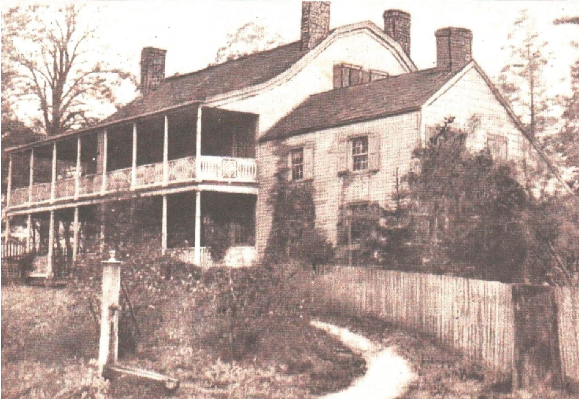The DeWitt Clinton House Historic Marker, located at the parklet triangle at Maspeth Avenue and 56th Terrace in Maspeth, is a welcome recognition (and replacement of the long-vanished previous sign at the same location) of both DeWitt Clinton and the site of the former house several hundred feet to the north which he owned from 1807 to his untimely death in 1828. The site, and the many important people associated with it, as well as DeWitt Clinton as an individual, contributed greatly to the history of Maspeth, Queens County, New York City, New York State, and the United States of America, as well as international ramifications in terms of history, economics, commerce, development and growth, among other significant trends.
Joseph Sackett Estate 1724-1755
The site referred to by the Historic Marker was a small hill, since levelled, several hundred feet to the north near a branch of Newtown Creek known as English Kills. In 1724, Judge Joseph Sackett built a substantial country “seat” described as a “two-story, four-chimneyed house… on a scenic piece of land near the Maspeth town dock.”
The Sackett family had previously settled on a large tract of land in Maspeth in 1656 adjacent to and including the English Kills bottomlands.
Judge Sackett, who sat on the Court of Common Pleas, was also a successful businessman who amassed significant acreage in New Jersey and elsewhere; in New Windsor, NY – coincidentally the birthplace of DeWitt Clinton – he controlled the central portion of the Chambers-Southerland Patent as well as over 8,000 acres in the adjacent town of Blooming Grove. In New Windsor, he also initiated the first ferry service to Fishkill (now Beacon), NY on the east side of the Hudson River.
Walter Franklin Estate 1755-1780
After his death in 1755, the property in Maspeth which included the site of the mansion was sold to Walter Franklin, a wealthy importing merchant from New York. Franklin Square, formerly at the intersection of Pearl and Cherry streets (now the Manhattan ramp to the Brooklyn Bridge), was where Franklin kept his in-town mansion and gardens; the mansion, constructed in 1770 and later known as the Samuel Osgood House, was used by President George Washington as his residence for the first year of his presidency.
During the Revolutionary War, the mansion in Maspeth was used as the headquarters for the British general Joseph Warren, who used its location adjacent to Newtown Creek to launch his invasion of Manhattan in 1776.
Isaac Corsa estate 1780-1807
After Franklin’s death in 1780, his mansion in Maspeth was taken over by his sister and her husband Colonel Isaac Corsa. Corsa was a veteran of the French and Indian War and also a successful merchant; he had run afoul of George Washington at the onset of the Revolutionary War and was imprisoned for a time for being a Tory sympathizer.
DeWitt Clinton estate 1807-1828
At his demise, the property passed to Walter Franklin’s daughter and son-in-law, DeWitt Clinton. During his tenure as owner – from 1807 until his death in 1828 – Clinton used it as a country retreat. It was here that his plan was formulated for the creation of the Erie Canal, which was said to have been inspired by the slow, shallow and navigable creeks adjacent to his property that emptied to one of the great centers of economic activity at the time, the East River. Indeed, according to accounts from the time, Clinton was intrigued with the idea of creating a canal from Flushing Bay in Queens to Wallabout Bay in Brooklyn which would bypass what was, in the early 19th century, the almost-impassable Hell Gate at the confluence of the East and Harlem rivers. Clearly, a theoretical canal constructed from Flushing Bay through Queens would most likely be connected to Newtown Creek, which empties a mile north of Wallabout Bay at the East River.
A legendary figure, DeWitt Clinton was, unsurprisingly, the most famous owner of the property. As a public servant – New York State Assembly Member (elected 1798); New York State Senator (served from 1798–1802 and 1806–1807); United States Senator (1802–1803); Mayor of New York City (1803–1807, 1808–1810, 1811–1815); Lieutenant Governor (1811–1813); Presidential candidate for the Federalist Party (1812); and Governor of New York (1817-1822, 1825–1828) – he was one of the most well-known people both in New York State and, after his run for President in 1812, the United States.
Outside of electoral politics, his imprint on the creation of the Erie Canal had massive implications for New York City, New York State and the United States. The “superhighway” of its time and initially derided as “Clinton's Folly” and “DeWitt's Ditch,” the Erie Canal transformed trade and transportation and generated enormous wealth and economic growth, particularly in New York. A historian and naturalist with a great interest in education, DeWitt Clinton was also instrumental in the organization of the New York Historical Society in 1804 and was later its president (1813–1817); was a Regent at the University of the State of New York (1808–1825); a member of the American Antiquarian Society and later its vice president (1821-1828); and was elected to the American Academy of Arts and Sciences in 1816.
David S. Jones estate 1828-1848
After his death, Clinton’s son-in-law, David S. Jones – a Queens County Judge and, at one point, New York City Corporation Counsel, took ownership of the Maspeth property. Jones was the son of Samuel Jones, considered by many to have created the modern legal and court system in New York State and known as the “Father of the New York Bar.” While David Jones continued to upkeep the Maspeth property, after he retired he built an impressive mansion in Massapequa which he named Massapequa Manor on significant acreage north of Merrick Boulevard; he also created Massapequa Lake, now part of the Massapequa Preserve and Nassau-Suffolk Greenbelt Trail, by damming Massapequa Creek, moving earth and creating an artificial island named after his wife, Mary Clinton.
After the completion of Massapequa Manor, Jones was in such dire financial straits that he had to sell the estate and come out of retirement. He settled back on the property in Maspeth for the remainder of his life. He was an original founder of St. Saviour’s Church, located a short walk from his property.
Edward Godfrey estate 1848-1870
After his demise in 1848, Jones' heirs sold the Maspeth property to Edward Godfrey, a leather merchant who founded E. Godfrey & Sons (located, coincidentally, on Pearl Street adjacent to Franklin Square which by that time was the center of the tannery business in New York City). Godfrey purchased the Maspeth property around the time he arrived in New York City from West Point.
A successful leather merchant – for almost three decades his firm was the largest leather goods manufacturer in New York – Godfrey retained the historic features of the estate during his ownership.
Generations partied at “Clinton Hall”
With his death in 1864, his sons placed the property up for sale. In 1870, it was purchased by a local dairyman named Philip Grussy who turned the property in to a beer garden and amusement hall. Named Grussy’s Clinton Park, it remained in operation for decades. However, under their ownership the house began to decline; in the 1880s, one of Clinton’s sons who had been born there attempted to visit the house but was unable to enter until his identity had been established. By the 1890s, the building had been subdivided into at least four apartments and was used as a tenement, and by the turn of the 20th century, news reports described the former country home as being “greatly dilapidated” and “permitted practically to go into ruin” by its owners. By then, this part of Maspeth was starting to become industrialized.
While intermittent appeals were made to preserve and protect the house over the succeeding decades, no help in saving the house materialized. The last development in connection with the estate and its famous former owner was Clinton Hall (the building still being extant), an amusement hall that, after its renovation and expansion in 1927, was described as “the largest dance hall on Long Island” with “ballrooms and bowling alleys, basketball courts and a pool room…the chandelier in the ballroom weighed in at two tons and had two thousand lights.” By this time, the house itself had fallen to ruin due to vandalism and in 1933 was destroyed by a fire.
Endnote
While there remains no trace of the estate and mansion that once graced this part of Maspeth and the area would be unrecognizable to previous generations, it is exactly for that reason that this replica Historical Marker is being placed back in the location of the original. There is no question that, after the recent bicentennial season of the establishment of the Erie Canal, the site that became DeWitt Clinton’s country seat should be remembered and rediscovered by the public.
Paul Graziano is an urban planning consultant & historic preservationist.




